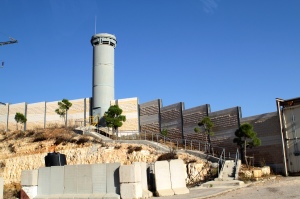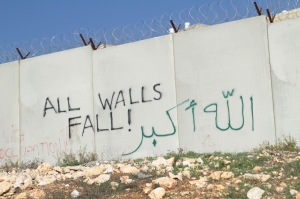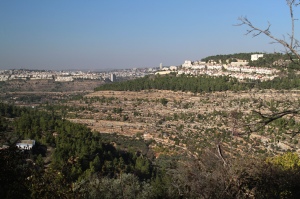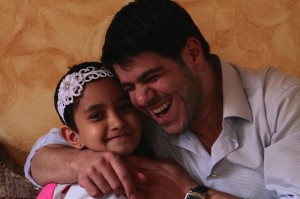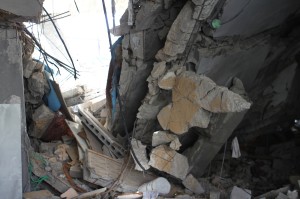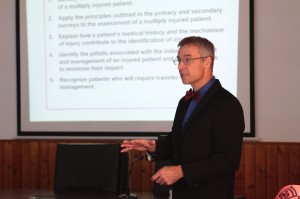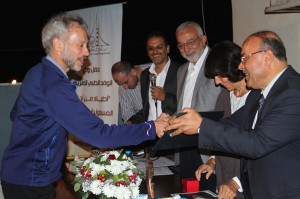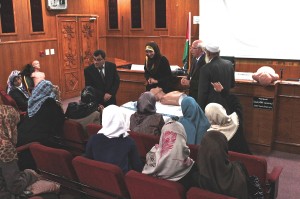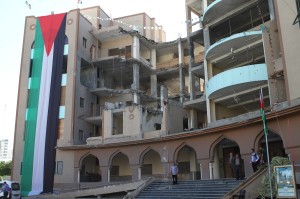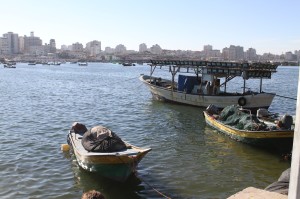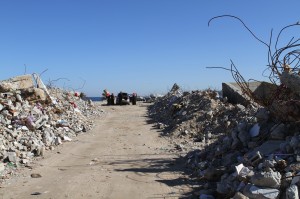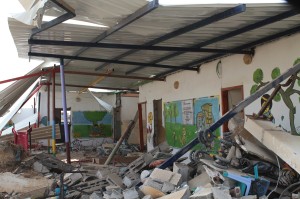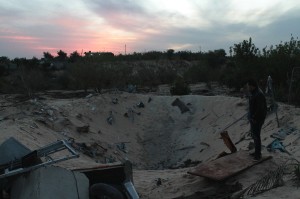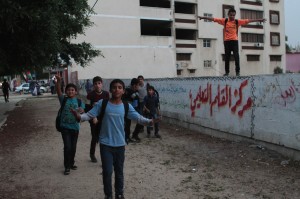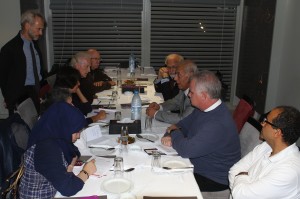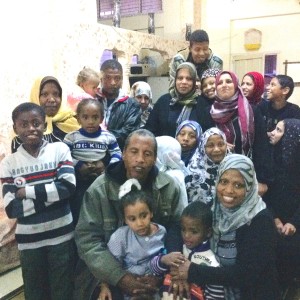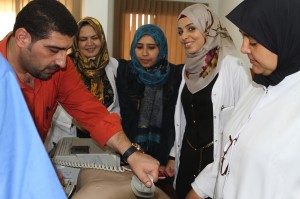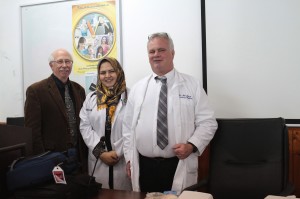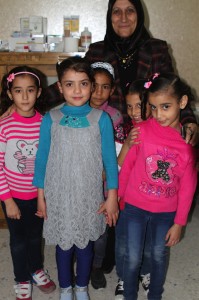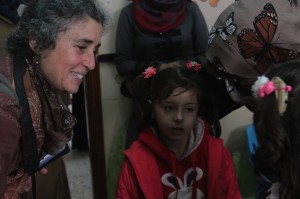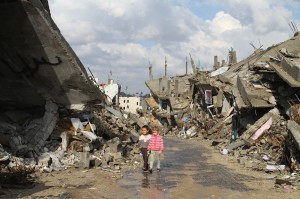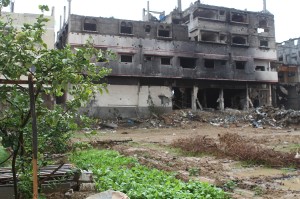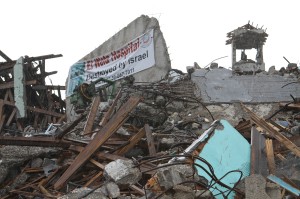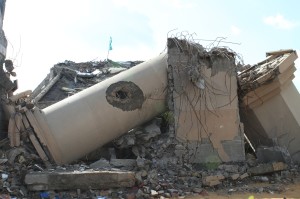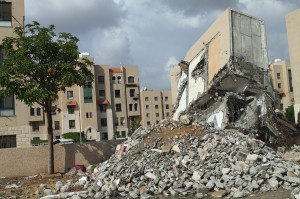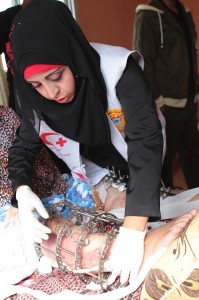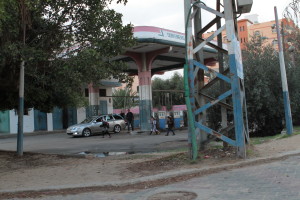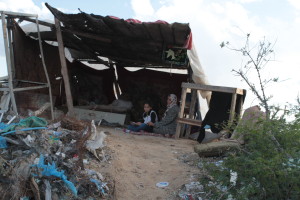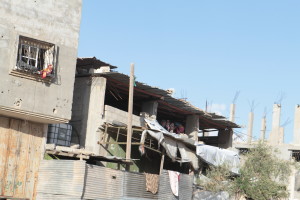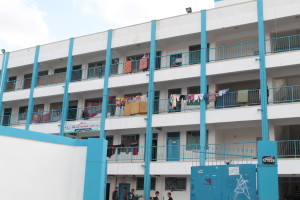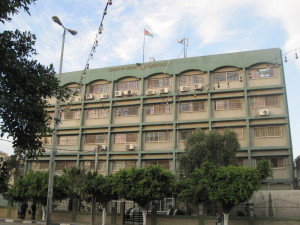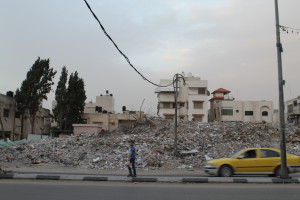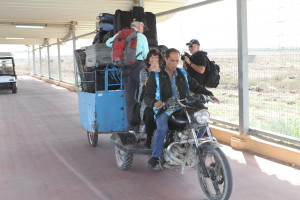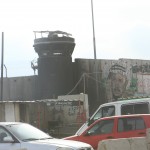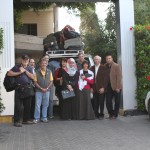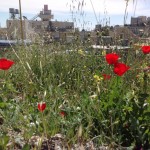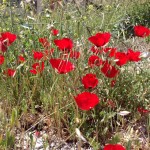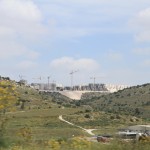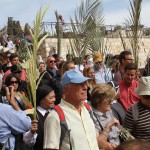This morning, we bid farewell to our friends in Gaza – hoping to see them again in April. Tonight, we are in Bethlehem – having taken a sobering tour of the areas around Bethlehem where land is being confiscated and freedom of movement for the Palestinians grows more and more restricted.
Yesterday morning, Maxine and I met with a group of women from Aisha, a women’s empowerment clinic. These clinics exist to serve the women of Gaza in many ways: psychological support, nutrition and exercise education, childcare education, promotion of skills for potential income generation. I asked the women to give us messages for the United States. These are their words…
Raneen: Thank God we are safe after the war. I live with my parents – they are my only things in my life.
Tell America: We are not enemies, but every time there is an election, they declare on war on us. That’s how they gain the popularity for an election.
Oifa: We live a very hard life. My house was damaged during wartime. I’m still living under very hard conditions. We want to end the internal problems. I came to Aisha to be helped. I have only one daughter – things are better since I’ve been coming to Aisha. I am learning needlework here.
Tell America: As long as bombing continues I am saying thank God we are safe. As long as we have God with us, we will always be the winners.
Futana abu Alra: I lived in very hard conditions during the war – I felt really bad – I had psychological problems and I came to Aisha to release the pain inside my heart.
Tell America: If America didn’t support Israel, the war wouldn’t happen.
Azhar: Thirty-three years old, divorced, four children (ages 6, 7, 9, 12). The children are with her husband. She is studying at the university and lives with seven people in two rooms. When she has finished university, she hopes to get a job and have her children with her. This war was the hardest of the three in the last six years. She says, “I used to live near Netzarim (where her children live) but now I live in Gaza City and couldn’t communicate with my children during the war. The ceasefire was a lie – I didn’t believe it – they bomb people – no one would allow me to see my children during the ceasefire. This was the first time I have ever seen dead bodies (Shatta area) – I was sick, psychologically depressed because I saw dead children. Things are easier since I came to Aisha – Aisha even served women during the war in mobile units. The war has had a huge impact – but we are a very strong people – despite the damage, we are sure we are the strongest people in the world and the Israelis are the weakest. They are strong with their guns, we are stronger with our personalities and our spirits. We had strong resistance and this made us feel stronger during the war.”
Tell America: “Our children whom you are always trying to kill are the ones who will free Palestine – no matter how many children you kill, our women will birth more and we will survive.”
Zeina Abdullah: mother of four children – two with autism. She and her four children live in one room with no doors and no windows. “You can’t imagine how much we suffered during the war. My 6-year-old autistic child was very scared during war. He kept shouting and screaming. I didn’t know what to do for him. I used to go to the doctor. They told me to keep hugging him. He was worse after the war. He was injured by the war. Whenever he heard the bombs, he ran. He fell on the stairs and was injured. Thanks to Aisha, I am in communication with Gaza Community Mental Health Programme and he will have his first visit tomorrow.”
Tell America: “We love peace and we love life – and we believe in peace. The living conditions in Gaza are very hard – I hope America will help to start rebuilding Gaza.”
Seraj: Mother of two children. “We suffered a lot during the war. Shrapnel and debris from the bombing of a neighbor injured my two-year-old.
Tell America: “We love peace and we need peace. No
matter what they do to Gaza there is something here that deserves living.”
Palestine: Divorced mother of four, ages 2 ½, 7, 9 and 11. She lives in the north of Gaza – the children live with her ex-husband in the south. They had no communication during the war and she lived with the really, really hard fear that they had died. Transportation is unaffordable so she doesn’t get to see them very often. Aisha helps her – she gets psychological support from Aisha.
Tell America: “No matter what America does to us, we are still the Holy Land – we are strong.”
Yusra: “I have lived in more than one war – the last war was the hardest – it hurt the people, the civilians, not the government. We want to live – we don’t want war
we want nothing to do with war. Israel is not respecting human rights. The last war, I suffered a lot – everyone was expecting to die, everyone wanted to die. Many people were displaced to hospitals and schools but this is not enough.”
Tell America: “They attacked us from the air and the land – where is the humanitarian law? There are no human rights in Gaza – we were out of water – even the air we breathe is poisonous.”
Rehab: “I was living during the war in two worlds Part of my family lives in Syria – they are in Yarmuk refugee camp. I was torn between here and there. During war I wouldn’t let my mother make a lot of food – I tried to make my family save food but we ran out of food. But even this was not like Syria where they ate animal food. I won’t feel happy until the people of Syria are also safe.”
Tell America: “They kill us with one hand and pretend to help us with the other. We want to live.”
Karam: 21-years-old. Completed grade 12. “I want a husband from America. Kidding – they are no better than Palestinian.” There are nine girls and three boys in her family. Her father is responsible for her married sisters. (unemployment in Gaza is 40% or more – and many people with jobs haven’t been paid for seven or eight months). Would like a job. The unity government didn’t fix anything. The psychological support provided by Aisha is very important – she is very happy here and has been taking training program with Germans for 10 days.
Tell America: “We are human beings, not animals or rocks – we love peace and we want to live.”
Ghadeer: 23-years-old – lives with parents – 14 people live in her house. Economic conditions are very hard and affect her a lot. She can draw – received training in art
wants to become an artist to help her family. Suffered a lot after the war – became more stressed – even with parents she was more nervous.
Tell America: “Despite the war, despite the siege, we are patient and will not give up.”
Lena: “You can’t imagine how hard this was – I saw martyrs for the first time.” In front of her house there were dead bodies of children – she is psychologically depressed and sad.
Tell America: “There have been enough wars – we are having enough of your wars.”
Shereen: 21-years-old – living in a house of three rooms holding 20 family members – doesn’t have a private room for herself and mother and two of her sisters – even her married brothers live in the same house. The economic conditions are very hard. She loves the most precious thing – her eye that was struck eight years ago and is now blind. Because there are 20 people in the same house, she doesn’t feel suitable in her own house. Is feeling really bad – always has a headache – receives psychological help at Aisha, but there is no medical treatment for her eye. She is not allowed to go outside and there is no freedom inside her house. Her father is dead and her brothers control the house. She is continuing her education in the university – but it is hard to study with one eye – wants to work in community service. Waits for morning to come so that she can come to Aisha. When she goes home
everything is worse. Cries every night with her sister.
Sleeps on the floor with children crawling on her body. When the war came, there was no room to hide in. Two missiles fell on her house.
Tell America: Hopes the world will help the Palestinians to improve their conditions. Wants to have freedom.
Rawan: 21-years-old – lives in a family of 14 members – during the war, severely impacted – house damaged, roof broken – water came in through the roof when it rained.
Running out of money – can’t rebuild the house. Thank god we are still alive. Comes to Aisha for relief of pain. “I hope to continue my education in order to benefit my community and country, but the economic condition don’t allow me to continue my education. Hope to find any kind of work to improve but no one is finding jobs.
Tell America: “I want to live like others do.”
Fida: 20-years-old. Like people in other countries, she dreams of stability and freedom. She also dreams of having a separate room for herself. She has no place to change her clothes – changes her clothes in the closet.
Tell America: “We need stability and freedom.”
Yasmeen: 29-years-old – lives in family of 12. “In our family, we are spending good time together – our living conditions were much better before the 1st Intifada – then worse and worse after the wars. What happened during the Eid – there was disaster in Shatta – Israel bombed 10 children. She hopes for improved living conditions, better economic conditions – she wants the borders open – she would like to visit the West Bank. She has been engaged for four years, but her husband-to-be lives in the West Bank and she cannot go out of Gaza.
Tell America: “Enough of wars – I hope to live in more stability and have more human rights like other countries do.”
Khlood: 19-years-old. Lives in a family of nine. During the war more thank 30 displaced people lived in her house. One of her aunts lost her home. Her Grandfather’s home was damaged. She relates that some people were scared, but she was not scared because this is usual. She experienced a shared experience: when they stop bombing, anxiety goes up – waiting for the bombing to resume.
Tell America: “Stop supporting war on Gaza. We want to live a normal life.”
During the summer war, in the central area of Gaza, a family was preparing the meal after fasting for Ramadan. Four sisters were gathered in the kitchen when, without warning, a rocket struck the house.
Three of the sisters were killed instantly – the fourth, eight-years-old, was blown through the front of the house and into the street below. At the hospital, she too was thought to be dead and was tagged to go to the morgue. Her cousin refused to believe that she was dead. He discovered that she had a pulse and insisted that she receive emergency treatment.
Infected scalp wounds complicated her subsequent medical course. She was comatose and was transferred to Jerusalem and then to Turkey. Eventually, she awakened and was stable enough to return to her remaining family – now living with relatives in an apartment provided by her cousin – a nurse.Bob and I visited this family today. The little girl has asked repeatedly for her sisters and her cousin had requested consultation on helping her with her grief. She sustained brain damage in the blast and has short-term memory loss and tremors.
Her cousin described the remarkable progress she is
making. We talked about constructing a memory book with photos and stories of her sisters. Since there are no photos other than in a smart phone and there are no keepsakes (everything in the home was destroyed), a notebook full of her stories and memories might help to create a record for her.The family is surrounding this child with love – we were grateful to meet them. More than 2200 Gazans were killed in the summer “war.” Of the more than 11,000 people injured, nearly 3,500 were children. Thousands of homes in Gaza are filled with people providing care in the presence of profound grief.
Grant O’Keefe, Bill Dienst and Ralph Reydell presented an Advanced Trauma Life Support course at Shifa Hospital today. The staff of the hospital has requested that this course and the Advanced Cardiac Life Support course be repeated in future visits. Ned Rosch has been enthusiastically received in presenting stress reduction instruction and has also been requested to return for more courses.Earlier in the day, Maxine Fookson and I met with a group of women at the Aisha women’s empowerment clinic. Tomorrow, I’ll post their comments.
This evening, our group was hosted at a farewell gathering. Many of the people we have worked with through this week joined the staff of the Gaza Community Mental Health Programme in singing “Happy Birthday” to Bob Haynes!
The Gaza community has proven again to be resilient and courageous. Nearly every person we talk with asks for justice and the right to live free from occupation. We are grateful to have been so graciously received and hope to return to Gaza in April of next year.
Medical students at the Islamic University in Gaza are similar to those in the U.S. Their faces reflect their willingness to learn, and their determination to help others.
But they are also different. To get to class, the students hurry past the administration building, with its blown out front half. They crowd into the single elevator still functioning in the classroom tower, but with only men or only women in each packed carload. When the buzzer signals that the elevator is overweight, one or two students get off and wait, as part of an apparently routine protocol practiced several times per day. When a class finishes, many of the students climb to the 6th floor, as the elevator no longer comes to the 5th floor.
As the elevator doors close and the elevator zooms downward, I am startled by the pitch-blackness. The students continue their animated conversations, never pausing, as many simply flip on the flashlights in their smart phones for the rest of the ride. They make a point of not stopping conversation whenever the lights go out in a dark room (OR, restaurant, private home). I don’t know if this is because they have become inured to so many things not functioning as expected (“This is Gaza”, they say with a shrug of their shoulders). Or if, by not recognizing malfunction, there is no malfunction – nothing to become alarmed about.
The classroom windows are covered with cardboard material. Walking sometimes has some crunching feeling, with tiny specks of glass left behind from the shards already cleared away.
The students received our photocopied course materials 2 days prior to the course, and memorized all of the algorithms, protocols, medicines, and other lists – cold. When we pose questions, many eager hands are thrust into the air to be called upon.
On their way home, the students walk past piles of rubble where an apartment building once stood, but say nothing about it. Once home, they recharge their laptop if the electricity is on, so that they can study when the electricity is off (the majority of the time). Study space is scarce for some students at home. One related that 51 people stayed in her two-bedroom home during the war.
One of the nursing students show me a picture that I took last April, and indicated a classmate who, along with her two little children, was killed when a bomb landed on her home last August.
The Gaza medical students have the same keen intelligence and eagerness as their American counterparts. But they also have experienced something that no one should have to experience.
Operating rooms and clinics are closed on Fridays – the holy day.
A few of us started our day with a visit to the Gaza seaport. Gaza rests along the Mediterranean in what could be one of the most beautiful places on earth. The water was sparkling and the sunlight was warm as we walked along the breakwater. What is not seen: fishermen are allowed to fish only three nautical miles from the shore – in water that is shallow and polluted by the tens of thousands of tons of sewage deposited daily from Gaza into the Mediterranean.
The ceasefire of August promised that the sea access limit patrolled by Israel would be increased to six nautical miles – but this has not happened. I had asked what was happening to the rubble concrete from destroyed buildings. At the port, we saw increasing walls of that rubble deposited on the sea wall. The volume of rubble from the many thousands of bombed buildings will require far more space than that available along this sea wall though and I wonder how it can be used.Our group then traveled by bus to have an overview of the current situation on the ground in Gaza. Hamada El Bayeri of UNOCHA joined us for two hours in the northern area. Hamada has guided our tours of Gaza on previous trips and we learn from his knowledge and wisdom.
Today, we returned to Shujayea to further understand the devastation of this summers’ attacks. Hamada talked about the need for Palestinians to be regarded as equal citizens of the world. Two weeks ago, Israel announced that Gaza would be allowed to export produce to the West Bank. Restrictions on fishing and the “off limits” areas along the border with Israel (35% of Gaza’s arable land) make production of salable items difficult. Hamada made the plea that we are hearing throughout Gaza: “We need to have equality and dignity.”
Having the world provide fish is not the answer; fishing for themselves and producing food is the answer. “We just want a chance.” Many educated people in Gaza are without jobs. Talented people engineered the production of tunnels. Hamada noted that if a Microsoft plant or other industries were available for workers in Gaza, tunnels would not be needed.One of the remaining dangers of the summer attacks is the high number of unexploded ordinance in the debris of destroyed homes. Last week, a four-year-old was playing in the remains of his home and was killed by the sudden explosion of one of the bombs. Approximately 15% of the 70,000 bombs that fell on Gaza during the summer are estimated to remain – so far – unexploded. Testing for the presence of toxic substances such as uranium 238 and other heavy metals from exploded bombs has not yet begun.
This afternoon, we journey to Khan Younis in the southern part of Gaza. Hosted by the family of a young man, Mohammed, now living in the United States, we toured through the area of Elzana, Khuzaa, Abasan and Bany Suhaila. In these border towns, Israel leveled many homes, mosques and businesses.
We ventured near the “no go” zone, and were told that Israel has agreed to allow farmers to enter this area. However, with many of us standing at the edge of the zone, it seemed we were threatening and a warning shot was heard. We quickly retreated.A twelve-year-old boy from our host family traveled with us to these towns and related that he has lived through three wars. This war, he said, was the worst – an assessment made by everyone we speak with. He was awakened one midnight by a bomb blast that struck a neighbor’s home. He and his family ran quickly to the neighbor’s house to discover nine people had been killed.
We enjoyed a dinner with Mohammed’s friends and family members then traveled again to meet with an Al Aqsa University professor. We wandered through his beautiful vegetable and fruit garden and were amazed by the production of food in dense, sandy soil. We were shown an enormous bomb crater and the early structure of a home being built to replace a garden home that was nearly completed when it was destroyed by a bomb.
To end the day, we were taken to a private basement museum and treated to classical Arabian oud music by a local group – music and culture surviving through war after war.
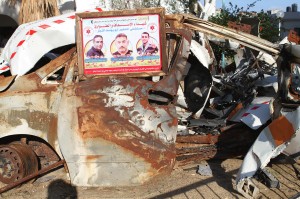
Photos of those who were recently killed by Israeli attacks are posted on cars and the rubble of buildings.
Each day we hear more stories. Here are a few:
During the 2014 war on Gaza, access to water was critical. It was summer, the weather was very hot and for safety, people were forced to remain inside their homes. The price of water was very high. Usually, there is grey water for toilet use and filtered water for consumption. During the war, only filtered water was delivered and the price was double. For many, water is delivered by truck and pumped to a tank on the roof of their building. Water truck drivers were very cautious about deliveries. Generally, two men deliver water – one to run the pump at the truck and one to place the hose on the roof. With armed drones visible above rooftops, only one man per truck ventured out. Families who wanted water were forced to send one of their family members to the roof to place the hose. A friend described the process of going to the roof with a hose, his wife and children terrified, watching and listening for drones, knowing that at any moment he could be targeted and killed.
Another friend told of medical supplies running low during the war. With the tunnels from Egypt closed, supplies now enter Gaza only through Israel. Following bombings when medicines, medical supplies ran low, we asked how did they get critically needed supplies. We were told that these items came through Israel but at a very high price. The cost of war in injury and the cost of war in treating the injury.
A young father related the days of having to stay in his house as being confusing for all the members of his family. Accustomed to having the father leave the house each day, the family was now clustered in their small living room – fearing the “knock” on the roof (Israel’s process of sending a warning to clear the house in advance of a bombing) and growing more restless and frustrated each day. “What am I to do?” he questioned. “I am the father, I am supposed to protect my children? Now they know and I know that I cannot protect them – there is no safety – there is no trust. When the attacks stopped, no one felt secure. To this day, no one feels secure. Everyone believes that the planes flying over our land could start again to kill Gaza.”
With a firm work ethic, a friend from previous visits told me that there is no work available in Gaza. During the war, jobs were available assisting journalists. This was extremely dangerous work – journalists were targeted and killed – but this friend risked working. Now there is no work. With the promise of reconstruction money that issued from the conference in Cairo, plans were made for jobs in rebuilding Gaza. But no money has been released. And so they wait.
Still another friend related the troubles faced by thousands who are now homeless. Many are sheltering with relatives, many in schools, and some in tents or temporary container buildings. Some have rented apartments, but the cost of renting a habitable apartment is prohibitive for most. With a median income of perhaps $200 – 300/month, a small apartment costs about $300 USD/month. Interestingly, prices for rent and major purchases such as computers or appliances are listed in U.S. dollars.
A medical professional related intricate plans for helping the people of Gaza to heal. Education of more mental health workers, plans for service in homes, and an attitude of promise that Gazans will continue to survive and eventually thrive keep this courageous man hopeful. There is no “giving up.”
Yesterday afternoon, I met with a group of women I’ve talked with in my last three or four visits to Gaza. These women, all mothers, tell me how life is now for them.
The war this summer was terrible – worse than any other in their memory. There seemed to be no end to it and everyone experienced the death or serious injury of someone close to them.
As refugees, these women receive assistance from UNRWA, but they report that UNRWA is now underfunded. The food assistance they used to receive has been cut in half and the financial assistance that had been 100 USD/month was cut to 80 USD/month and now is zero. Food is scarce and life is tenuous. The bombs this summer did not strike them, but they were close enough to rattle the windows of their homes and they continue to fear what might be yet to come.
As we talked, the room filled with children who were curious and friendly – the older children picking upthe younger and carrying them around the room. The front door remained open, allowing light to filter in from the street – the electricity is cut for at least 12 hours each day and my visit was in an electricity-free time.
Bill Dienst and Bob Haynes continue to teach advanced cardiac life support classes every day. Bob reports that their students are enthusiastic and the classes are fun to teach. The students have so far been members of the staff at Shifa hospital. Tomorrow, Bob and Bill will be assisted by faculty to teach a large group of medical students. On Saturday, their classes will be for nursing students from Islamic University.
This morning, several of us traveled to the Palestine Future Association – the Gaza Center for Cerebral Palsy – to meet with Dr. Al Kashif, Director. This inspiring man walks through rooms of children, gently touching heads or arms and receiving brilliant smiles of recognition and care.
The Center cares for all children in Gaza who have cerebral palsy – speech therapists, physical therapists, teachers of many special areas care tenderly for individual children and for integrated groups.
We were invited to dance with the children – several of them in wheel chairs. We had a lovely time and were inspired by monumental work being done in an environment affected – as is all of Gaza – by the siege. More equipment is needed. We brought gifts of Ipads to help the older children in developing computer skills.
We stopped at a kindergarten to donate some of the books and learning supplies that were given to us to bring to Gaza and we were
treated to Debka dancing by a wonderful group of 5 – 6 year olds, who also invited us to join them in their dance. One of the girls danced beautifully but did not smile. Her parents were killed in separate wars.This afternoon, we visited the Al Amal orphanage. The only orphanage in Gaza, Al Amal shelters 120 boys and girls from 5 years to late teens. This summer’s disaster left 1700 more children orphaned – adding to the 22,000 already needing care.
Most orphans are cared for in their families, but for some this is not possible and Al Amal serves as many as possible both in the facility and by visiting in homes. A much larger facility is needed! This facility is immaculately clean. Each child is responsible for maintaining her/his living space and food is prepared in a spotless kitchen.
Psychological support, physical education and cultural activities are provided on site and the children attend UNRWA schools. Still, the numbers of children needing care are overwhelming and the traumatized children who became orphans this summer require special attention. They are the unpublicized victims of war.
(Washington Physicians for Social Responsibility has traveled to Gaza since 1993. Since 2009, following the Cast Lead invasion by Israel, WPSR has sponsored eight medical delegations to serve the besieged, imprisoned and war-torn people of Gaza.)
In my language I know of no word or words sufficient to describe the scenes we saw today as we drove through the Sujayea area of Gaza. Around us, thousands of bombed-out wreckages of homes; before us, the shattered remains of the Al Wafa rehabilitation hospital. Imagining the families whose lives were forever changed in those brief moments of summer 2104, and then watching as family members now walked between the shards of their homes will remain with me forever.
One family, whose home was spared so that Israeli soldiers could claim it and live there for a time of occupation, has returned to repair the damage done by the soldiers to the inside of their home and to begin replanting their garden. Some families who have nowhere else to go occupy the shells of homes. These homes are statistically referred to as “partially destroyed” – even when the front of the home is missing and residence is claimed in rooms with only three sides.
In the rubble, fragments of toys, furniture, cookware, linens – the common stuff of life – provide startling reminders of a community. Why was this destruction deemed necessary? Who lives with the responsibility for this decision in their heart?
People who were living their lives, already struggling under siege, experienced the death of family members and now grieve loved ones, their homes and their community.
Earlier today, we had watched a community in action. We traveled with staff of the Palestinian Medical Relief Service to a remote area home where the homeowners had agreed to shelter a mobile clinic. A long line led from one of the rooms in the home – now designated as an exam and treatment area for the services provided by PMRS staff.
Physicians, nurses, physical therapists and other health care professionals make up the PMRS mobile clinic teams that go into areas where poverty makes it difficult for people to travel to central medical care. There are four such teams in Gaza and they see patients in these home (mobile) clinics each day.
We visited a home where the PMRS dressing team was caring for a bedridden woman. This woman’s legs were broken and burned by a war blast in August – a blast that killed her eight-year-old daughter as they walked through a market. For a time, the woman had been cared for in a Jerusalem hospital. When she was returned to her home, the PMRS team assumed responsibility for her daily care – she is healing well while she also grieves.
PMRS served Gaza in an expanded group of ten mobile clinics during the 51 days of attacks – braving travel that proved lethal for some medical workers in Gaza.
Everywhere we go in Gaza, as in previous visits, we meet courageous people who are intent on making life better for Gaza. This morning, we visited the Al Amal Cochlear Implant Center. Al Amal functions in two buildings. One is a rehabilitation center for helping children utilize their implants. Here, the classes are small and speech therapists work with groups of children to help them fully utilize the implants. The second facility is a school where students with implants are successfully integrated into classrooms with non-hearing impaired students.
Al Amal claims the highest honors for their work. Many of the children they serve are hearing impaired due to war injuries. Cochlear implant equipment is expensive and the waiting list for service at the Center is long.
Throughout Gaza, many healthcare workers and
support people are working without salaries. The trauma of war, poverty, the siege, and environmental destruction challenges every citizen.At dinner tonight, we met with Dr. Muhammad Al Kashif, Director General of International Cooperation of the Ministry of Health. As he reviewed the challenges to life and medical care here, we expressed our gratitude to him for welcoming us to Gaza. His generous work with staff from the Gaza Community Mental Health Programme has made it possible for our teams to work in Gaza.
(Washington Physicians for Social Responsibility has traveled to Gaza since 1993. Since 2009, following the Cast Lead invasion by Israel, WPSR has sponsored eight medical delegations to serve the besieged, imprisoned and war-torn people of Gaza.)
This morning, all of the physicians in our group worked at Shifa Hospital. Grant O’Keefe is in general and trauma surgery, Don Mellman and Ralph Rydell saw patients and observed surgeries in their neurosurgery specialty area, and Bill Dienst and Bob Haynes taught Advanced Cardiac Life Support. Maxine Fookson, pediatric nurse practitioner, lectured to nursing students and John Van Eenwyk, psychologist, lectured and consulted with the staff of Gaza Community Mental Health Programme (GCMHP).
Ned Rosch and I delivered suitcases full of medicines to GCMHP. The medicines, funded by donations from Iowa and Washington state, were joyfully received. Many of these medicines were out of stock in the GCMHP pharmacy and are needed for the care of traumatized, war-affected Gazans.
Ned and I were then given a tour of children’s facilities in Deir Al Balah, an impoverished area in central Gaza. The inspiring work being done by Reem Abu Jaber and her colleagues to help the children of this area is many faceted. A Waqf (Google – this was Reem’s gift) kindergarten founded four years ago is functioning beautifully. Last April, Reem (who was the original director of Qattan Center for the Child in Gaza City), received permission to open an Arts and Cultural Center for Children.
NAWA receives educational support from Waldorf Steiner personnel of Germany and is opening its doors to an increasing number of children. This is a resident area, not a refugee area, and the UN does not serve resident children. On the logo for Nawa, a quote from Edward Said reads, “The Power of Culture rather than the Culture of Power.” NAWA presently functions in a very small space but will soon move to a larger home – thus, increasing its capacity to serve neighborhood children.
Reem’s new project – planned for opening in April 2015 – is the renovation of a 1700-year-old Christian monastery. This centrally located building will be the first library for the children of Deir Al Balah in more than 40 years. Children and friends in the US sent with us books and financial support for Reem’s projects.
This afternoon, members of our group toured Beit Hanoun children’s specialty hospital, which was damaged by Israeli weapons in the war this past summer. The neighborhoods around the hospital were badly damaged in a process known as “mowing the lawn.” Families continue to live in makeshift shelters. Many of these shelters were constructed of cardboard-like material that was damaged by recent heavy rains. Some of the homeless are camping in local UN schools (UNRWA) while students continue to double shift for classes.
The physical and psychological toll of war lives in every resident of Gaza. No one was untouched by the summer’s tragedy. That people are able to carry on with love for one another is humbling.
When night falls, Israeli planes regularly fly above Gaza – emphasizing the precarious nature of the present ceasefire. Nearly everyone we talk with mentions the expectation that war will come again.
This evening, a nurse from Al Aqsa Hospital visited us in the Marna House garden. This gentle and generous young man told stories of members of his own family who died or were desperately injured this summer. His grandmother’s chest was lacerated by a piece of shrapnel and this nurse changed her dressings every day for three weeks, carefully observing for and protecting against the possibility of infection. One of his cousins was blown from her home and is brain damaged. Realizing that his relatives were homeless, he gave up his apartment to 10 family members and now is happily “rebinding connections” with his parents.
During the war, I was in touch with this nurse and know that he worked endless shifts in his hospital and slept rarely. He is truly an inspiring soul.
Saturday evening as we prepared for the bus trip to Gaza, Amos Givertz of “Don’t Say We Didn’t Know” joined us for dinner at Neve Shalom to speak about the work of Israeli peace activists.
Today, we journeyed once more to Gaza. Nine medical professionals entered through the Erez Checkpoint – hosted again by the Gaza Community Mental Health Programme (GCMHP). We miss those who have traveled with us in the past and welcome new members of our team. Our thoughts are with Dr. Rich Grady and his wife, Dr. Laura Hart as Rich recovers from major surgery. Many in Gaza will miss them during this visit.
Entry through the Erez Checkpoint is complex – requiring a time-intensive (weeks) application process and patience from all sides to gain entry permission. The physical entry is arduous, comprised of numerous entry and passport checks and a long walk (or ride on a tuk tuk – see photo) through a metal cage – overseen by the armed Israeli guard towers along the separation wall.
We were greeted on the Gaza side by staff of GCMHP and after clearing the Palestinian checkpoints; we began the stunning drive through Beit Hanoun – site of numerous summer bombings. We heard from our hosts stories of loved ones who were killed or tragically injured during the 51 days of warring in July/August. Driving through Gaza, destroyed buildings appear in shocking frequency. Sites such as the Ministry of Finance were targeted – see before and after photos.
A quick check-in at the Marna House was followed by a loving greeting at the GCMHP Center. Friends and colleagues welcomed us and told of their summer of sorrow. Gaza Community Mental Health staff work constantly to help the traumatized people of this seacoast enclave. Densely populated (1. 7 – 1.8 million people in 340 sq. Km), the people of Gaza live with the continuous knowledge that air, land and sea attacks can begin again at any moment. The echoes of death, injury, destruction of homes, businesses and schools haunt them.
Work begins: the three surgeons, one cardiologist and one emergency/family practice physician met with colleagues to plan the days ahead. The nurse practitioner and stress management provider will be busy. The psychologist in this group has served before in Gaza and will work with the GCMHP staff. My work will be varied and I look forward to time with women empowerment groups, the cochlear implant staff, orphans, schools, a new arts/culture/library center director and other interactions that will involve many members of our team.
Generous donations from people in Iowa and Oregon and Washington have provided the critically needed medicines and medical supplies, books and toys that filled our luggage. We look forward to giving these gifts from so many who care about Gaza.
- Israeli guard tower at Qalandia on the way to Ramallah.
- The WPSR delegation leaving the Marna House.
- Poppies in Bethlehem.
- More poppies in Bethlehem.
- Israeli settlements are everywhere.
- Pilgrims on Palm Sunday.
(Washington Physicians for Social Responsibility has been sponsoring delegations to Gaza since 1993. In 2009, the group began offering medical service work to the people of Gaza.)
Leaving Gaza is always difficult: difficult to leave our friends knowing that their imprisonment continues, difficult to contemplate how much strength it takes for them to maintain their courage and hope, and then the minor difficult of the transit through the checkpoints. Two friends came early to Marna House Hotel to say “Good-bye.”
Moving across the small segment of land through the Gaza and Israeli checkpoints can take many minutes to many hours. On the Israeli side, every item in our luggage was checked and scrambled. One day later, we are still finding objects in our suitcases that belong to one another! Yet, finally, yesterday, after about 2 ½ hours we emerged and were greeted by the driver sent to us from our friend Daniel of Bethlehem. The day was spectacularly beautiful and we drove the curving road up to Bethlehem – where we will spend nights until we return to the US.
In the afternoon, on our way to dinner with Mustafa Barghouti and his staff from the Palestinian Medical Relief Society in Ramallah, we stopped in Jerusalem to observe the thousands of pilgrims walking from the Mt. of Olives to the Old City, celebrating Palm Sunday.
Settlements dot so many hills in the West Bank – erected on occupied land against international law. Leaving Area C, moving into Area A, the Israeli Qalandia checkpoint was slow, but we arrived in good time in Ramallah. We had a wonderful dinner – planning the next two days of service in Ramallah, Tulkarem and Hebron. We are grateful to Wi’am in Bethlehem for helping us to organize our time in the West Bank and to the Palestinian Medical Relief Society for providing opportunities for us to serve in West Bank communities.
